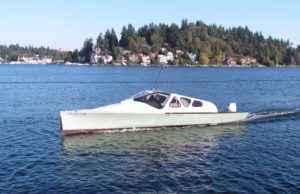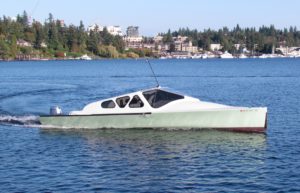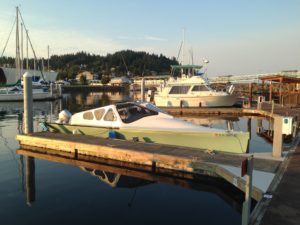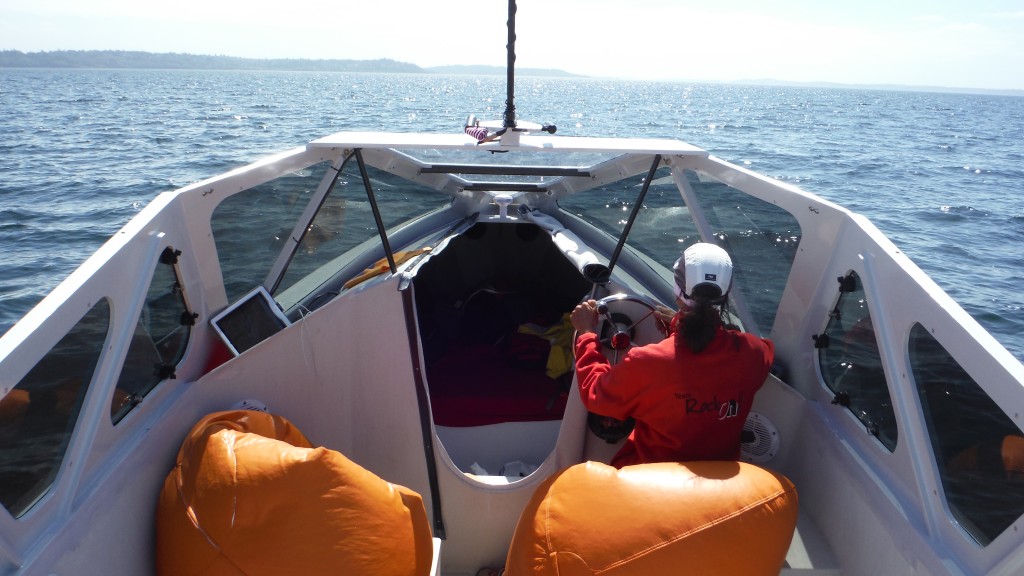Retro started life as an Ultimate 30 built of carbon fiber over a Nomex core. She was created as a racing skiff built by Australian boat builder, McConaghy Boat Works in the late 1980’s. The boat was designed by the famous Aussie 18 skiff racer, Ian Murray. Murray designed the Ultimate 30 to be sailed by 10 professional sailors in a world-wide professional sailing circuit. Unfortunately, the circuit never really caught on. A handful of boats were sold in America. As the one-design class fell apart, their value decreased to scrap value.
One of the pros who sailed the boat was Jonathan McKee of Seattle. McKee bought this boat, sailed her for a while then got an idea to use some of the parts in a boat designed by Paul Bieker (Bieker is now the head of design for the Oracle America’s Cup team). That boat was the first Riptide 35, Ripple, which received the mast, boom and bow sprit removed from what is now our camping/cruiser Retro.
Retrofit #1 – Family Outboard Runabout
With the mast, keel, boom and sprit gone, the hull was slated to be chopped up until Bieker stepped in and saved it from the junk yard. Paul converted the hull into a highly efficient family runabout outboard motor boat. He and his family used the boat for years.
When Bieker took over as the lead designer for the Oracle America’s Cup team, the boat spent more time under a tarp than in the water. In 2014, we purchased her from Paul.
Retrofit #2 – Cruising Camper
We are retrofitting the boat once again. This time the boat is going from a family runabout to a more fully enclosed cruising boat designed to go far (not fast) on a tank of gas. Our goal is to keep all the trailerability and highly fuel efficient attributes of the outboard powered boat and equip it for cruising off-the-grid for extended periods.  We are experienced boaters who want a boat optimized for the varied waters of the Inside Passage between Seattle and Alaska and also for the shallow waters of the Inter-coastal waterway on the east coast of the US. The interior is designed for a cruising couple that only need a few creature comforts.
We are experienced boaters who want a boat optimized for the varied waters of the Inside Passage between Seattle and Alaska and also for the shallow waters of the Inter-coastal waterway on the east coast of the US. The interior is designed for a cruising couple that only need a few creature comforts.
The boat hull is extremely light. To keep the advantages of the light-weight hull, the retrofit to cruising needed to minimize weight whenever possible. We’re using light weight equipment and reducing windage whenever possible
Electronic Equipment:
The decision was made early on to only use one main battery (primarily for starting the motor). The house battery was replaced in the design by a distributed system utilizing the built-in batteries of high tech camping and biking equipment. The only true boating elements in the navigation system are the power sipping Vesper Marine xb-8000 AIS/Wi-Fi/GPS/Transponder and a Standard Horizon GX2000 VHF/AIS radio. The nav data from the xb-8000 is output via Wi-Fi to an iPad and iPhone for all navigational displays. The iOS devices run off their own batteries unless plugged into USB chargers running off the outboard motor. Even the antenna has unique circuitry that takes all three antenna requirements (VHF, AIS and FM) and TX/RX (simple wiring) them over a single powered antenna made by Vesper Marine. All lights inside and outside are LED. Each cabin has a set of rechargeable AAA battery powered lights. The anchor light is a high-tech bright white bicycle head-light with a 150 hour battery life (easy 3 weeks of summer cruising). We even have a shower that is powered by an internal lithium ion USB rechargeable battery. To keep all these devices charged, we have 9 USB outlets that draw power when the motor is running. When the motor turns off, the devices are switched over to their internal batteries thus eliminating the need for a house battery and saving about 50 lbs.
Fuel Burn Rate:
The hull form is perfectly matched to the goal of a fuel efficient cruising boat. In our first summer cruising tests, we cruised at about 15 knots (70% power) burning just over 1GPH (1.1gph). The hull has a very low wetted-surface and actually planes instantly. There is no awkward bow-up transition to planing speed. Cruising at eight knots or 18 knots, the hull is level and smooth…and very fuel efficient.
Knowing how efficient the motor is running is key to getting maximum fuel economy. The new Honda 50hp is plugged into a NMEA 2000 network that outputs the fuel flow rates onto the boat’s iPhone/iPad. If tide and wind conditions are pushing the boat along, a decision can be made to either keep the increased speed or throttle back to 15 knots and take advantage of the lower fuel burn.
Cabin Space:
Sleeping is done on either the forward v-berth or yet-to-be-built aft sleeping deck (via blow up queen sized mattress). The main cabin and helm area have stand up head-room for 5’8” Susan but not for 6’8” Scott. The headroom changes at anchor when the entire 9-foot ceiling of the main cabin pivots up to create eight feet of headroom.
The triangle side windows next to, and across from, the helm station open 180 degrees to allow cool breezes to flow in the summer, easy line handling when going through the locks or reduction of side-windage in adverse docking conditions.
There are two sinks in the v-berth cabin and the main cabin has a simple galley with drop down silicon sink, two Jet Boil stoves (from the mountain climbing world) and soft storage bags for dishes, utensils and accessories. There are multiple storage areas low in the boat built next to hull. Two of these areas utilize our cool Pacific Northwest ocean waters to keep fruit, veggies and drinks cool. No refrigeration beyond the cool spaces is planned.
The complete retrofit and detailed fitting out of the boat is scheduled to take another two winters.
Specs
Draft: 10 inches (motor partially up w/ prop in the water)
Length: 30 feet
Motor: 50 HP Honda
Speed:
Cruising @ 70% power : 15 knots
Max power : 22 knots
Prop: 3 bladed aluminum w/13” pitch
Fuel Consumption:
Preliminary Trials: 1.1 gph at 70% power
Hull Construction: Carbon fiber over Nomex core.
Fuel Capacity: 20 gal tank (19+ usable)
Fuel Range: 230 miles w/ 20 mile reserve (early estimates based on preliminary trials)
Head: Port-a-potty + li-ion rechargeable shower
Galley: 2 JetBoil burners with multiple pans and attachments
What did Paul Bieker say about his inspiration to build the original outboard family runabout?
“Nemo (renamed Retro by Burbanks) is my personal runabout. She is the result of blind chance, opportunism and intuition rather than engineering and design. When that (Riptide 35) was finished I could not bear to see the beautiful hull broken up so Jonathan gave it to me. There was not enough volume in the hull to allow sufficient ballast for efficient sailing so I decided to turn it into an efficient powerboat. In a grass lot, with nothing but a sawzall and a grinder, some plywood, foam, glass and epoxy I “chopped and channelled” the boat [into an outboard]. Although a bit quirky to handle and wet, she is fun, efficient and a great source of conversation.”
-Paul
